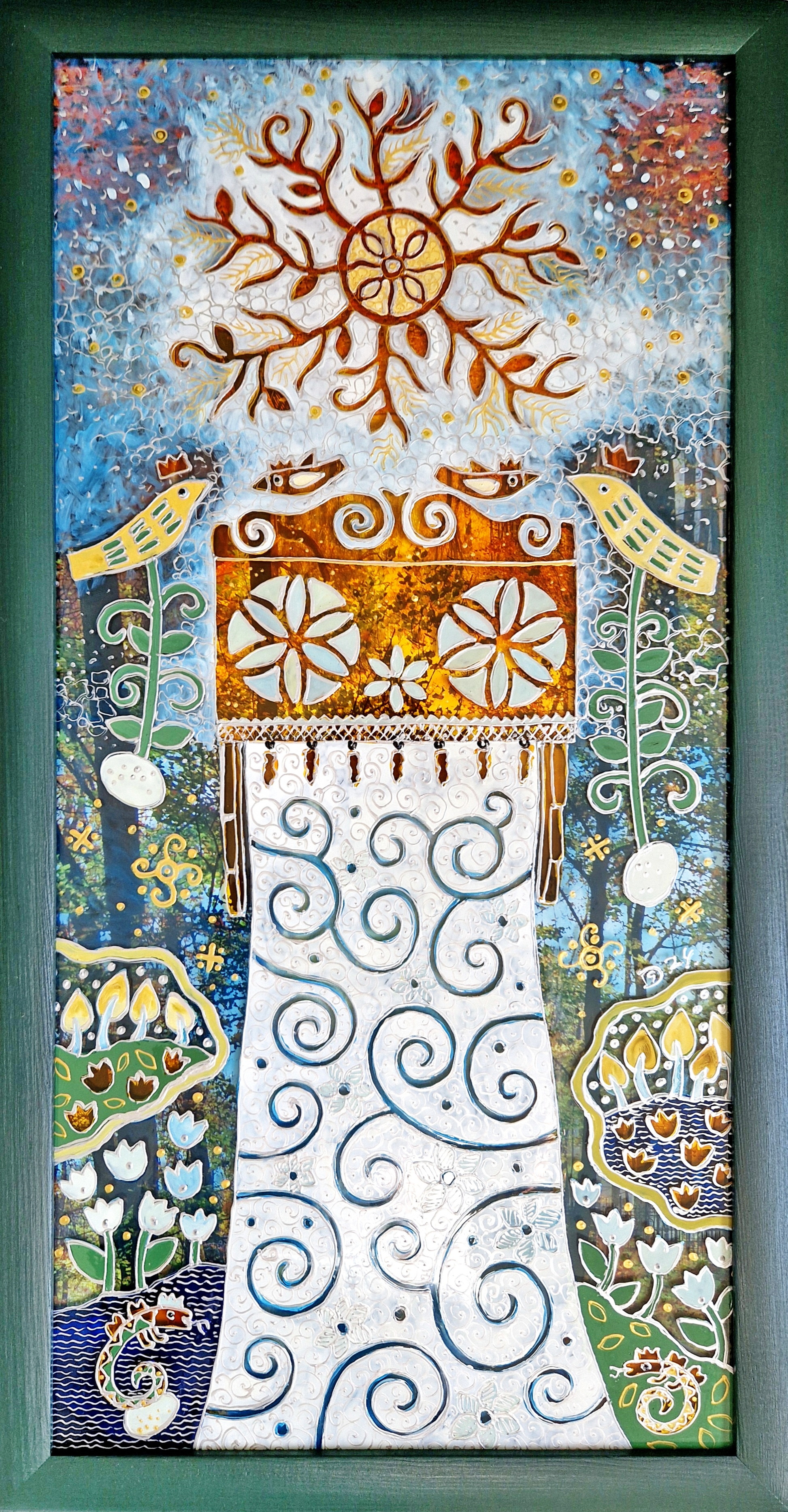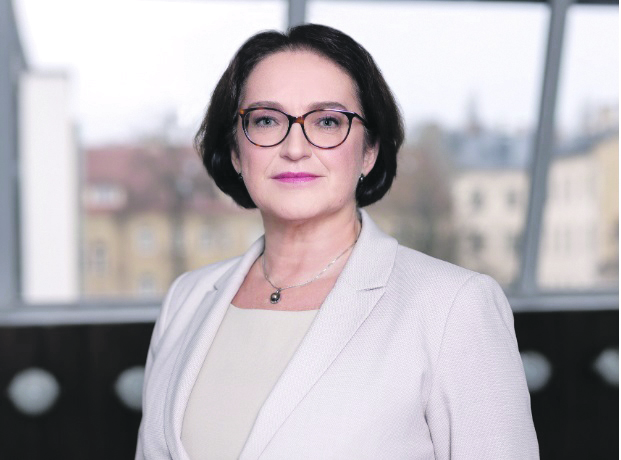The creator of the colored world sends the wish of happiness

– How do you introduce those who do not yet know D. Stalauskienė briefly?
– I was born in Paežeris village, Šilalė district. I studied at Upyna Secondary School and studied at Šiauliai Pedagogical Institute. I live with my husband Amber in Moletai, I have three daughters. I create on the glass, become silk, decorate dishes, cut carp, take pictures. I have organized a number of colorful paintings on glass exhibitions in Utena, Moletai, Ignalina, Anykščiai, Rokiskis, Ukmergė, Kėdainiai, Šilutė, Kaunas and other cities.
– Do Kaunas – just a guest on your creative path, do you still have deeper links with our city?
– I have a lot of links with Kaunas, but several times I was invited to exhibit here at the Goldūvis Gallery at the Center of National Culture – the Golden Piece. Kaunas residents could see my works at the Museum of Ethnic Culture of Antanas and Jonas Juska, Vilkija.
– You are not only a creator but a family man. How do you feel like an artist, wife, mom, grandmother? What do your daughters do today – maybe she followed in the footsteps of a creative mom?
– Yes, I am a free artist in terms of activities. I have such a luxury of creating unhindered government work and commitment, listening to my heart and planning time according to my mood, inspiration or air outside the window.
In the family, I am a wife, mom, grandmother, and even more broadly sister, aunt, stepfather, brother, martyr … Only a long time ago no one can call me a daughter. I can – I raised three. All go their own ways, work, create families, raise children, travel – just like most young people. Although he has sensitive and artistic souls, no one became an artist. I am laughing that so far.
Subtly: The colorful works of D. Stalauskienė are dominated by nature motifs, national symbolism, mythological images. / Photo by D. Stalauskienė’s personal archive
– You worked for a long time in teaching. When did you decide to leave it in the past, and to dedicate all everyday life? What led to this transformation?
– After graduation, I entered the then Pedagogical Institute, where there was a field of art studies. I have been working in an educational institution after my studies, but it will be ten years, as I have no longer considered its door. The workloads in schools were decreasing, and this is where exhibitions began to increase. Then I decided to become a free artist who is only creative.
I remember a lot of beautiful things from those times – circles’ activities, drawings adorned with school walls, children’s drawing exhibitions, contests, Olympics, but I wouldn’t want to go back. The motivation fell when the students who did not like art classes performed the tasks of the art classes, and I criticized themselves – why can’t I be interested in them? It’s a hard feeling. One rest I thought: I would sit in your place and draw, just let nothing interfere with. Apparently, those thoughts came true with time. Now I do it. The educator must be the organizer and the wizard, and I am more lonely.
I jokingly call myself an artist: I better work because I know what I want and what I do. It is really difficult to give up something to another. Perhaps a person is concerned with things in life.
– When did you first feel that glass is not only material but your vocation? What did it appear better than canvas or paper?
– It has to do with a slightly more complex phase of my life. I was looking for ways to earn a little extra and get away from everyday worries and thoughts. In the past (and at that time) I cut the carp. I put a lot of them in them. People praised and were happy to be beautiful, but only. It was my leisure time.
Glass paint helped to color more than just glass – with them a lot of change, as if I had begun to color life itself. People liked, I received support, orders. From smaller to larger volume, from a simple composition to a more complex, from a small picture to a series of paintings. From this, today’s « variegated glass » – my website, facebook page. True, there were always (there are) dishes decorating next to the glass. Hundreds of them would be filled!
What is the technique of painting on the glass better than the canvas or paper? Apparently for each of their own. I’m just more interesting. I discovered a way to turn a glass painted with stained glass paint to turn a picture on the wall. The course and stages of creation are so engaging that nothing otherwise you want.
Photo by D. Stalauskienė’s personal archive
– Folk art motifs – bright in creation. What associates you so strongly with this culture? What characters have become your favorites?
– Folk culture is important to all of us, we all have its need and impact, but maybe not all of us think about it, we are not all recognized by ourselves, we are not all listening. I succeed. Once upon a time, through folk songs, chests of screens, tapes, books, literature read, now through the longing of the past and the desire to remember what I have never seen.
I have written, « Sometimes I am past dreaming – my own and foreign homeland, weaves and utensils, rhythms, patterned items that are silent and talking about being and deeds, people who have not been discussed in the depths but were deep. The romance and pain of the past. » The strangest thing is that it is not at night, not while sleeping, but living everyday life. I try to remember, I try to choose, I try to ignore it, I try to push. What does not give up, I put the image on the glass. I really want to be beautiful. And for those whose dreams do not visit but notice what happens more beautifully in reality. To all. I am glad if I help someone to understand or recognize it.
I have many favorite motifs – the edges of the headscarves, the scorch patterns I mentioned, the carved motifs of spindles and towels, weaves, ribbons, calendar holiday symbols and so on
– You mentioned the chest patterns you moved to your work. Did you collect them while traveling around the regions, looking for your ancestral heritage museums and books?
– During my studies I sang in the folklore ensemble, I paid more than 300 folk songs, and I wrote my diploma work on the theme of Lithuanian folk. I went through the villages, visited people’s homes, museums, and collected all the necessary information about folk art motifs, but they were lying in the drawer for a long time until they finally reborn in my work.
– Nature in your work is alive. I guess her motives come from childhood memories?
– Really. I grew up in the homestead – between sand, dirt, rowan, chestnut, moms nurtured flower beds, daddy’s beloved garden. I knew the most beautiful forms of vegetation there. And now I like to organize excursions to all kinds of nature – the green, snowy, raining, blooming, darling … She’s our true home. Maybe that’s why I often crown birds, fish, trees, rain in my work.
The paint helped to color more than just glass – with them a lot of change, as if I had started coloring life itself.
– How is your work born – do you have any rituals without which it would be difficult to start the creative process?
– They are born out of intense thinking. It happens constantly and otherwise I no longer jump. Everything is thoughts. There are so many of them that I do not add all to my creation. Although we see the end result on the glass, I start working from the line on paper. There is a sketch that I cut on a glass sheet, then color, combine background color options, and finally frame. I have no special rituals. Thoughts must be bright. This is enough for the brush to feel comfortable in the hands.
– Are there days when the image does not make a sense and the glass looks like silent?
– There are. Then I do my creative space, I take a silk decoration or go out to nature to look for birds. I take pictures of them. In Moletai, there was several exhibitions of my birds I had done.
– What encourages you to constantly go to a time where you never lived? Maybe creation about the past helps to better understand the present?
– Maybe. Back in my childhood, I thought I was born too late. I was curious to hear, to read later, to sing for a while, and especially to imagine how it was. Stopped in time, with the spell and longing for the past, I try to talk about a time I have never been to. This is how the cycles of stories emerged: « twelve calendar leaves », « aprons », « portraits of the old park », « ancestral dictations », « to be things » and others.
– Do you have the signature of your creative work – a symbol, a motif, a line that will betray that it is undoubtedly your job?
– Recently, one woman wrote that she immediately recognized that it was my work. You have created, as you have signed. I accept it as an assessment. Then nothing special is needed when the artist’s style is also an identification code. It remains to be signed in the corner, for example: DS.25. The number marks the year of creation.
Photo by D. Stalauskienė’s personal archive
– To be an independent artist today – is more freedom or challenge? Would you like your daughters as well?
– I have no exact answer. It means a lot to me – everyday life and joy, search and self -expression, the ability to observe not only what’s in your horizons, but also what lies in unknown worlds. The road is not easy. Fantasy is one, drawn is another, exhibited third, to earn a paint and frame is fourth. But everything is going and I’m happy. Happiness is the most important thing I wish for my daughters. In what way, in what activity, in what relationship I would not predict, because they are their way and their time.
– Painting on glass is a very meticulous job. Perhaps we can talk about similar features of your character – precision, perfectionism?
– I’m not a pedant, but I like the saying « order must be ». It must be by my understanding. If there is, then it is easier to engage in creative work that requires an empty space where there is no thought of disadvantaged shelves, unpacked dishes, uninitiated laundry or « what’s for dinner »? However, each other’s dust on furniture never interferes. Accuracy? Be sure. I try to do everything as agreed, promised, planned.
– You mentioned that you are also interested in Latvian ornamentation. Do our neighbors’ national writings, the colors bring new insights you move to your creative work?
– Interest is more aesthetic. I have several Latvian ornamentation books that analyze patterns or present them in authentic objects. I use those ornaments in creation similar to Lithuanian signs: after all, these are our common Baltic symbols. Latvian maybe a little richer, especially in bands.









:format(webp)/s3/static.nrc.nl/images/gn4/stripped/data132618282-42d96f.jpg)